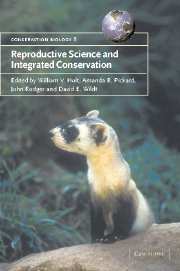Book contents
- Frontmatter
- Contents
- List of contributors
- Foreword
- Part I Introduction
- Part II Reproduction and population viability
- 2 Behaviour and reproduction
- 3 Nutrition and its interaction with reproductive processes
- 4 Environmental chemicals and the threat to male fertility in mammals: evidence and perspective
- 5 Assessing the consequences of inbreeding for population fitness: past challenges and future prospects
- 6 Impacts of inbreeding on components of reproductive success
- 7 The major histocompatibility complex (MHC) in declining populations: an example of adaptive variation
- 8 When is the birth rate the key factor associated with population dynamics?
- Part III Reproductive techniques for conservation management
- Part IV Integrated conservation management
- Part V Reproduction science in non-mammalian species
- Part VI Conclusions
- Index
- References
5 - Assessing the consequences of inbreeding for population fitness: past challenges and future prospects
Published online by Cambridge University Press: 21 January 2010
- Frontmatter
- Contents
- List of contributors
- Foreword
- Part I Introduction
- Part II Reproduction and population viability
- 2 Behaviour and reproduction
- 3 Nutrition and its interaction with reproductive processes
- 4 Environmental chemicals and the threat to male fertility in mammals: evidence and perspective
- 5 Assessing the consequences of inbreeding for population fitness: past challenges and future prospects
- 6 Impacts of inbreeding on components of reproductive success
- 7 The major histocompatibility complex (MHC) in declining populations: an example of adaptive variation
- 8 When is the birth rate the key factor associated with population dynamics?
- Part III Reproductive techniques for conservation management
- Part IV Integrated conservation management
- Part V Reproduction science in non-mammalian species
- Part VI Conclusions
- Index
- References
Summary
INTRODUCTION AND OBJECTIVES
The worrying prospect that genetic deterioration may threaten the viability of wildlife populations was first brought to the attention of the conservation community by Frankel & Soulé (1981). The issue has since been hotly debated and widely researched. It is reasonable to assume that wildlife may suffer inbreeding and associated inbreeding depression resulting from continuing erosion of natural habitats and increasing reliance on captive breeding. Indeed all evidence points to this being the case (Ralls et al., 1988; Crnokrak & Roff, 1999). In any case there exists a series of simple relationships providing a clear expectation that population viability may be threatened by inbreeding and loss of genetic variation. It is worth briefly reviewing those here.
Since genetic variability is the raw material for evolutionary adaptation, it follows that genetically invariant populations cannot adapt to environmental change, and are thus not ‘buffered’ against it (see Ryan et al., Chapter 6). A corollary of this is that any trait that evolves must have genetic variation, and is consequently open to the effects of loss of genetic variation.
Demographic bottlenecks reduce genetic variability in a manner described by a series of theoretical relationships (Falconer & Mackay, 1996). In general, prolonged small population size is expected to cause a decline in allelic diversity and, to a lesser extent, heterozygosity. Conversely, if a population recovers quickly from a bottleneck then loss of genetic variation, especially heterozygosity, may be minimal.
- Type
- Chapter
- Information
- Reproductive Science and Integrated Conservation , pp. 67 - 81Publisher: Cambridge University PressPrint publication year: 2002



